Drunk on beauty
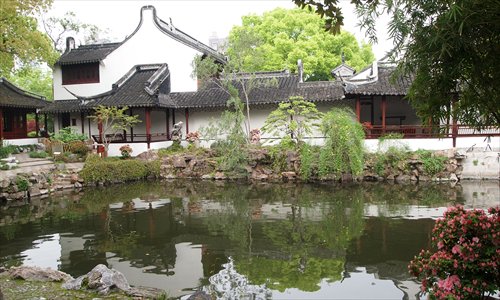
The lotus pond, the centerpiece of Zuibaichi Park Photos: Ni Dandan/GT
Near the end of metro Line 9 in the west of Shanghai is one of the city's five ancient gardens. Exiting the Zuibaichi Park Station, you'll find yourself in Songjiang district and just by the gates to the city's oldest garden, which has been expanded into Zuibaichi Park.
A pagoda originally dating back over 900 years is also nearby the station. Both offer a tranquil and relaxing experience, although the management offices of both sites suggest that visitors avoid the first day of the May Day holidays when the biggest crowds are expected.
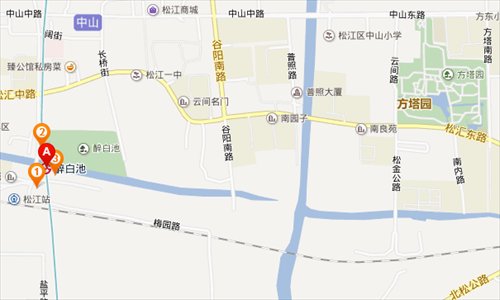
map
Intoxicating pond
Zuibaichi, literally drunken Bai pond, is part of the former residence of a Songjiang jinshi (advanced scholar, a level in the ancient imperial exam system) named Zhu Zhichun during the Song Dynasty (960-1279). In the late Ming Dynasty (1368-1644), famous Chinese painter and calligrapher Dong Qichang expanded the compound. He used to invite literati to recite poems and create their works here.
Later on during the Qing Dynasty (1644-1911), painter Gu Dashen made the place his personal villa and rebuilt it. He inherited and further highlighted the essence of classical Chinese garden architecture. A 700-square-meter lotus pond became the centerpiece while bamboo, plum blossom, man-made hills and stones were arranged to create a garden scene in the typical southern China style.
The name Zuibaichi was given since Gu was thinking that if Li Bai, the renowned Chinese poet, were brought back to life and had a walk around the place, he would get drunk on the atmosphere.
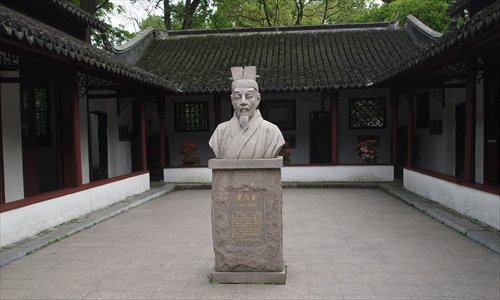
The statue of Dong Qichang in Zuibaichi Park
Today, Zuibaichi has been expanded into a park occupying 50,000 square meters at the center of Songjiang. It's one of Shanghai's five ancient gardens together with Yuyuan Garden in Huangpu district, Guyi Garden and Qiuxia Garden in Jiading district and Qushui Garden in Qingpu district. Zuibaichi is the most ancient given its history of over 900 years.
Visitors can see ancient garden architecture here including elegant pavilions, the zigzagging and winding ancient galleries, stone sculptures and painted rafters.
They can also lose themselves in luxuriant plants of all colors. As summertime is around the corner, lotus flowers will soon bloom.
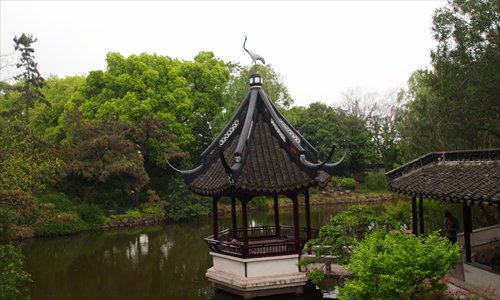
A pavilion in Zuibaichi Park
Address: 64 Renmin Road South, Songjiang district
Opening hours: 6 am to 5 pm
Admission fee: 12 yuan (free between 6 am and 7 am)
Square Pagoda
Just a five-minute taxi ride from Zuibaichi Park lies another historic site in Songjiang, the Square Pagoda, which was also originally built more than 900 years ago. The 42.5-meter-tall brick-and-wood structure has a distinctive slender body and broad eaves. Imposing, orderly and neat, it is typical of the Tang Dynasty (618-907) style. It's often said to be reminiscent of a fair and graceful young lady in a skirt and is regarded as the symbol of ancient Songjiang.
The nine-story pagoda is very limited in terms of interior space. The wooden steps are steep and narrow.
"Due to safety concerns, visitors are now only allowed to climb as far as the fifth story," a managing officer of the Square Pagoda Park surnamed Ma told the Global Times. Climbing the pagoda costs an extra 5 yuan ($0.80).
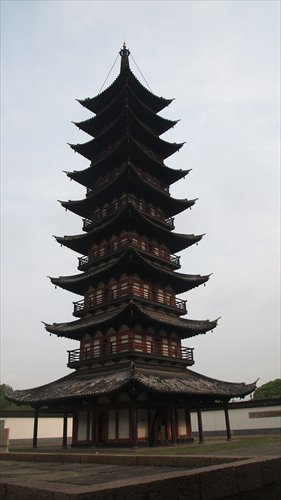
A view of Square Pagoda
Renovations to the pagoda were made during the Ming and Qing dynasties, but the main structure and style remain the same as the original. Today more than half of the wooden rafters under the eaves, the brackets and the lintel above the arched gate are original materials.
A major restoration of the pagoda costing 200,000 yuan was carried out in 1974. The park around the pagoda was built in 1978. Covering an area of nearly 122,000 square meters, the Fangta Park as it is called opened in 1981.
Not only visitors but many film making crews have been attracted to the site. Many television series like Romance of the Western Chamber and The Peony Pavilion were shot here.
Screen Wall
The park has more on offer other than the pagoda. Among the ancient relics is a wall just north of the pagoda, called zhaobi, or screen wall. Measuring 4.75 meters high and 6.1 meters wide, the wall dating from the Ming Dynasty was built to obtain auspiciousness in front of the gate of the City God Temple in Songjiang. Today, it's the most ancient and best-preserved large-scale brick sculpture piece in Shanghai.
The wall is embossed with an ancient mythological animal, which bears a dragon's head, a lion's tail, a bull's body, a deer's legs and the scales of a fish. The animal is called tan, literally greed. Locals say it's meant to warn people against the vice.
The wall survived bombings during the War of Resistance against Japanese Aggression (1937-45) as well as the Cultural Revolution (1966-76) where anything old was considered bad and many ancient structures were destroyed.
To the south of the Square Pagoda is another attraction, the Wangxian Bridge. Constructed in the Song Dynasty, the stone-and-wood bridge presents a smooth and slightly arched line. Simple but elegant lotus flowers are carved onto the stone pillions at both ends. The patterns can be clearly seen from a small platform built just beneath the bridge.
Address: 235 Zhongshan Road East, Songjiang district
Opening hours: 6 am to 5 pm
Admission fee: 12 yuan